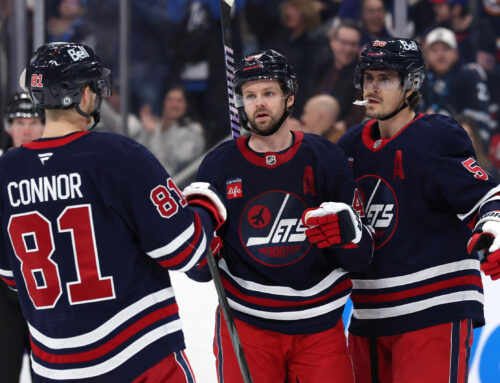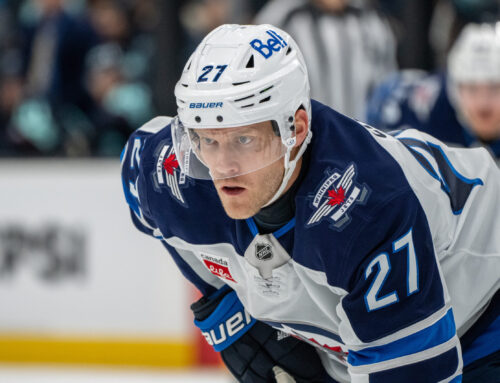
Four defensemen off to hot starts and four who are disappointing – in the Western Conference
Part three of this series explores some defensemen off to hot and slow starts this season. Many defensemen are particularly reliant on the power play for their production. Thus getting more power play time, of a change to their team’s power play fortunes can have an inordinate effect on a defenseman’s point totals. Looking at defensemen who are receiving unusual amounts of power play time early in the season can be an indicator of the potential for greater than usual success. Just be wary of a defenseman filling in for an injured teammate.
Hares
At almost a point per game this year it is pretty much a given that Suter is going to slow down. The question then becomes how much he slows down. If he slows down to last year’s pace he becomes a very replaceable asset who has more name value than fantasy value. A return to the his old 40-45 point ways would see a lot of his value return. Looking at Suter’s performance last year it is evident that his even strength production was not the culprit for his dip in production. At even strength he had his third best season in the last decade. That is despite only scoring on one of every 100 shots he took. Last year the power play killed Suter but the Wild power play is back and with it Suter’s power play production. Suter already has a third of the power play points he had all last season as the Wild are clicking at just over 21%. The return of Suter’s power play points means a return to previous value levels for this workhorse.
Last year Klingberg announced his presence as he put up points in a big way even after he regressed from his hot start. This year he has started where he left off, scoring on over 10% of his shots as well as sporting a better than 10% on-ice shooting percentage. With his continued high-level production has come two extra minutes per game over-all and more than half a minute more per game on the power play. Bringing him up to 23.5 minutes at even-strength and 3.5 minutes per game on the power play. It is hard to bet on Klingberg continuing to score on more than 10% of his shots as no defenseman has managed that feat twice in the last five full seasons. The 10% on-ice shooting percentage is far more likely to continue given the way the Stars score and his power play usage and huge offensive zone starts. Klingberg is on the verge of becoming one of the better offensive defensemen in the game, and should continue to be as long as the Stars are an offensive juggernaut.
Oliver Ekman-Larsson (OEL)
This season OEL’s numbers have been unusually assist heavy. That can probably be attributed to the fact that for the first time in a long time the Coyotes have an abysmal power play. In limited viewing it appears the Coyotes have gone away from their blue-line centric power play. Despite that OEL is still getting shots on the power play at the same volume he always has. That is probably due more to the fact that OEL is averaging more than six per game on the power play as his shots have not increased proportionally with his power play ice time. This lends some credence to my observance that the power play does not seem to be based around him anymore. A nice counter balance for OEL is that he is being consistently used in more offense-centric situations. This season he has some of the highest offensive zone starts on the Coyotes as well as a severe reduction in his penalty killing minutes. The defensive minutes have gone to Nicklas Grossman, Zbynek Michalek, Klas Dahlbeck and Connor Murphy. This type of offensive usage for OEL would enable him to hit 50 points on a good team, on the Coyotes it will enable him to maintain the status quo 40 points.
The most impressive numbers for Parayko thus far is the fact that he is taking close to three shots per game. In the last four full seasons only 12 defensemen have taken more than 240 in a shots in a season, all of whom are big name offensive defensemen such as Dustin Byfuglien, Brent Burns and Erik Karlsson. Each of them have done it twice over that time period. The point being that defensemen who take a lot of shots, even in the neighbourhood of 200 shots in a season tend to be high-end offensive defensemen, or major power play presences. He is due for a dip when Shattenkirk returns but it should not be a major dip as even when Shattenkirk was in the lineup Parayko was getting close to two shots per game. As long as Parayko keeps firing shots at a high rate he will continue to produce goals. This makes him especially valuable in leagues in which goals from defensemen are worth extra.
Tortoises
Muzzin is being used a lot more on the penalty kill this season as the Kings need to replace Regehr’s minutes there. The uptick in shorthanded minutes has not effected his power play minutes but has cut a minute per game at even strength. That might be a little worrisome except that he is on pace to shoot more this year than he did last year. At his current rate he could hit 200 shots this season. He is also driving play at his usual rate as his corsi is up around 60% as has come to be expected. The combination of his corsi and his own shots suggests that Muzzin’s point production should start to increase, as does his exceedingly low PDO of 95.9. The problem for Muzzin is that the Kings do not score much as they average in the neighbourhood of 200 goals a year. Thus while his point production will increase the addition of Ehrhoff could eat into the points available for Muzzin.
It has been some time since Enstrom has been considered a high-end offensive defenseman. That is partially due to his problems with injuries and partially due to a new found inability to produce on the power play. That recent ineffectiveness looks to have finally resulted in a reduction to Enstrom’s power play time. After four consecutive years of receiving more than three minutes of power play time per game Enstrom is now receiving half a minute per game. For a defenseman who has only produced more than 20 points at even strength in a season twice in seven years this is a devastating development. Unless there is an injury to one of Myers or Byfuglien it will be a long unproductive season for the once promising defenseman.
With Vatanen playing on the snake-bitten Ducks it is necessary to distinguish whether his slow start is team-related or due to a change in his game. If Vatanen is the issue it would be reflected in significantly reduced power play usage or a drastic reduction in his shot rate. That does not seem to be the case as his power play usage has dropped minimally and he is shooting more than in past years. That suggests a team issue, especially with a current on-ice shooting percentage hovering around five percent. It is worrisome, however, that the Ducks are taking significantly fewer shots with Vatanen on the ice despite him getting some of the highest number of offensive zone starts on the team. There is evidence though that suggests that may be collateral damage from playing mainly with Clayton Stoner. It is too early to tell with Vatanen as his underlying numbers, with the exception of the aforementioned on-ice shot rate, seem to suggest that when the Ducks bounce back his production will too.
Kris Russell played on the second unit of the Flames power play until Mark Giordano’s injury yet still managed to rack up the most power play points he has had in a single season. Something closer to his career average could drop Russell closer to 20 points rather than the 30 points he had last year. Russell also seems like member of the Flames’ back end to be most likely to have his power play minutes cuts with the return of TJ Brodie and the arrival of Dougie Hamilton. That would seem to be further backed up by the increase in short handed minutes that Russell has been handed. Given his shot blocking prowess, along with Wideman and Hamilton’s respective defensive issues and better offensive skills it would make sense for Russell to be the odd man out offensively. Furthermore, the Flames on-ice shooting percentage is due to drop this year and is already two points lower than last year. All told, this looks to be the real Kris Russell.





 FLA
FLA CHI
CHI NYR
NYR PIT
PIT L.A
L.A COL
COL MTL
MTL ANA
ANA STL
STL N.J
N.J VAN
VAN ARI
ARI
